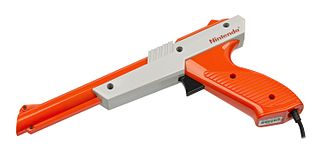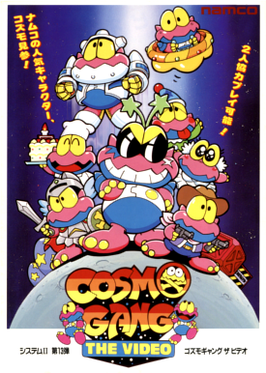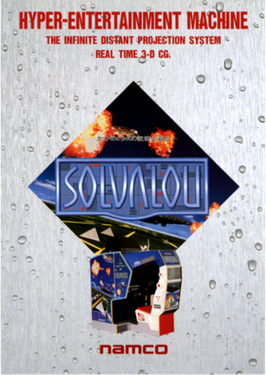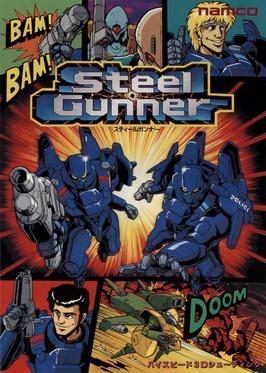
A light gun is a pointing device for computers and a control device for arcade and video games, typically shaped to resemble a pistol.

Virtua Cop is a 1994 light gun shooter game developed by Sega AM2 and designed by Yu Suzuki. It was originally an arcade game on the Sega Model 2 system, and was ported to the Sega Saturn in 1995 and Windows in 1996. The Saturn version included support for both the Virtua Gun and Saturn mouse, as well as a new "Training Mode" which consists of a randomly generated shooting gallery.

Time Crisis II is a 1997 light gun arcade video game developed and published by Namco. It is the second installment in the Time Crisis series. The game incorporates the same mechanics of its predecessor, with some minor changes, but with the addition of co-operative two-player gaming. The game's story focuses on the efforts of two secret agents, Keith Martin and Robert Baxter, as they attempt to thwart the efforts of a industry mogul's plan for world dominance.
Manabu Namiki is a Japanese video game composer who is primarily known for his work in shoot 'em up games. He has worked with game companies such as Allumer, NMK, Raizing and Cave. In October 2002, Namiki, Hitoshi Sakimoto, and Masaharu Iwata founded Basiscape. The trio had worked for NMK for sound production under the title "Santarou" before the employment, so he started to assume the handle when appearing on the chiptune scene and performed live at the Japan Chiptune Tour 2004. He is currently the sound director at M2.

Pac-Attack, also known as Pac-Panic, is a 1993 falling-tile puzzle video game developed and published by Namco for the Super Nintendo Entertainment System and Sega Genesis. Versions for the Game Boy, Game Gear and Philips CD-i were also released. The player is tasked with clearing out blocks and ghosts without them stacking to the top of the playfield — blocks can be cleared by matching them in horizontal rows, while ghosts can be cleared by placing down a Pac-Man piece that can eat them. It is the first game in the Pac-Man series to be released exclusively for home platforms.
Point Blank, known as Gun Bullet, or Gunvari in Japan, is a series of light gun shooter games developed by Namco for the arcade, PlayStation and Nintendo DS; the trilogy was first released in arcade in 1994 and was later ported onto the PlayStation. Point Blank DS was released in 2006 for the Nintendo DS featuring 40 challenges from the original series.

Air Combat is a 1995 combat flight simulation video game developed and published by Namco for the PlayStation. Players control an aircraft and are tasked with completing a series of missions, with objectives ranging from destroying formations of enemies to protecting a specific target from enemy fire. Missions award money that is used to purchase new fighter aircraft, each with its own unique weapons and strengths.

Cosmo Gang the Video is a 1992 fixed shooter arcade game developed and published by Namco. A home conversion for the Super Famicom was released the same year. Controlling the Hyper Beat starship, the player is tasked with ridding the galaxy of the Cosmo Gang, a race of aliens that cause mischief across Earth. Gameplay involves shooting enemies and avoiding projectiles. Power-up items can be collected to grant the player additional abilities. It ran on the Namco System 2 arcade board.

Solvalou is a 1991 first-person rail shooter arcade game developed and published in Japan by Namco. The sixth entry in the Xevious series, the player takes control of the Solvalou starship from a first-person perspective as it must destroy the Xevious forces before they take control of Earth. The Solvalou has two weapon types: an air zapper to destroy air-based enemies, and a blaster bomb to destroy ground-stationed enemies. It runs on the Namco System 21 arcade board.

Point Blank DS is a 2006 lightgun shooter video game developed and published for the Nintendo DS by Namco Bandai Games. It is the fourth entry in the Point Blank series, comprising both new stages and ones taken from the first three games. Players use the touch screen to complete a number of different minigames that vary in terms of mechanics, such as protecting an on-screen character or shooting down a specific target.

Steel Gunner is a 1990 first-person shooter arcade game developed and published by Namco. Players take control of Garcia and Cliff, a duo of police officers that are part of the Neo Arc police force, as they must use their powerful Gargoyle mecha suits to destroy the STURM terrorist organization, who have taken captive scientists Dr. Ryan and Dr. Ellis to create a world-ending superweapon. Gameplay revolves around using a crosshair to shoot down enemies and avoid harming civilians. It runs on the Namco System 2 Plus arcade hardware.

Time Crisis: Project Titan is a light gun shoot 'em up video game for developed by Flying Tiger Entertainment and published by Namco for the PlayStation in 2001. It is a spin-off of Namco's Time Crisis series, serving as a direct sequel to the PlayStation port of the original Time Crisis.

The GunCon, known as the G-Con in Europe, is a family of gun peripherals designed by Namco for the PlayStation consoles. The original controllers used traditional light gun technology, while newer controllers use LED tracking technology.
Light-gun shooter, also called light-gun game or simply gun game, is a shooter video game genre in which the primary design element is to simulate a shooting gallery by having the player aiming and discharging a gun-shaped controller at a screen. Light-gun shooters revolve around the protagonist shooting virtual targets, either antagonists or inanimate objects, and generally feature action or horror themes and some may employ a humorous, parodic treatment of these conventions. These games typically feature "on-rails" movement, which gives the player control only over aiming; the protagonist's other movements are determined by the game. Games featuring this device are sometimes termed "rail shooters", though this term is also applied to games of other genres in which "on-rails" movement is a feature. Some, particularly later, games give the player greater control over movement and in still others the protagonist does not move at all. On home computer conversions of light-gun shooters, mouse has been often an optional or non-optional replacement for a light gun.

Sorcer Striker is a 1993 vertically scrolling shooter arcade video game developed by Raizing and published in 1993 by Able Corporation in Japan and Europe. In the game, players assume the role from one of the four bounty hunters to overthrow the Goblin empire led by King Gobligan and reclaim the bounty placed by King Codwenna of Violent Kingdom over Gobligan's head. It is the first entry in the Mahō Daisakusen trilogy, which includes Kingdom Grand Prix and Dimahoo, and the first video game to be created by Raizing.

Tank! Tank! Tank! is a 2009 third-person shooter arcade game developed and published by Namco Bandai Games. It was ported to the Wii U in 2012, where it was a system launch title in North America. Players control their respective tanks and must destroy opponents and giant mechanical monsters with a variety of weapons, such as machine guns and rocket launchers. Its gameplay has been compared to titles such as the Earth Defense Force series, through its usage of B-movie tropes and parodying.

Shoot Away is a 1977 electro-mechanical (EM) light gun shooter arcade game developed and published by Namco. Players use the shotgun-shaped light guns to fire at clay pigeons, represented as flying white dots on a projector screen. There are two that must be shot down in each round, and players only get two bullets to hit them. Bonus points are awarded for shooting the pigeons as soon as they appear, or by destroying both of them with a single bullet. The game was a critical and commercial success, maintaining a presence in arcades into the 1980s.

Cosmo Gang the Puzzle is a 1992 falling block puzzle arcade video game developed and published by Namco worldwide. The third game in its Cosmo Gang series, succeeding that year's Cosmo Gang the Video, players stack groups of blocks and aliens known as Jammers in a vertical-oriented well. The objective is to clear as many objects on the screen before they reach the top of the screen. Blocks are cleared by aligning them into complete horizontal rows, while Jammers are cleared by defeating them with blue-colored spheres.

Mr. Driller G is a 2001 puzzle arcade game developed and released in Japan by Namco for its System 10 hardware. It is the third installment in its Mr. Driller series, and the last released for arcades. Controlling one of seven characters, players must make it to the bottom of the level by destroying colorful formations of blocks. G introduces several new ideas to the series, such as power-ups, a story campaign, and online multiplayer.

















